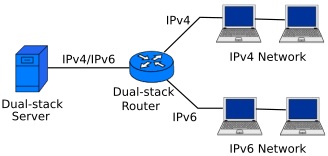IPv4 to IPv6 Transition With the Dual-Stack Technique
By Stephen Bucaro
The IPv4 addressing scheme uses a 32-bit address, which provides for over 4 billion possible
addresses. You would think this, along with Network Address Translation (NAT) and class networks
networks (A, B, C) would be enough addresses. Unfortunately with the advent of held-held
internet connected devices and the Internet of Things (IoT), we are facing IPv4 address
exhaustion. To solve this problem, on June 6, 2012 the Internet Engineering Task Force
released RFC 2460 - Internet Protocol Version 6 (IPv6).
Among other improvements, IPv6 has increased the address size to 128 bits, which provides
for over 340 trillion, trillion, trillion addresses. Eventually, all networks will use IPv6,
unfortunately, transition progress has been slow. That's because it's costing a huge amount
of money and effort to enable both protocols to operate simultaneously and to convert legacy systems.
To operate the Internet, the Domain Name System (DNS), has been modified to map IPv4 addresses
to IPv6 addresses. For reverse resolution, the IETF reserved the top-level domain ip6.arpa
for the reverse DNS database, where the scheme is defined in RFC 3596. For the typical business
organization's local network, there are several techniques to deal with the conversion.
Assuming that you can't immediately convert all your network hardware to IPv6, you can
use address translation or tunneling techniques, but the dual-stack technique
allows the easiest operation of IPv4 and IPv6 devices on the same network. The dual-stack technique
has been used in the past to allow IPX or AppleTalk devices to work with IPv4 devices on
the same network. To use the dual-stack technique, a dual-stack router or dual-stack server is required.

In the diagram shown above, a server is configured for both IPv4 and IPv6 addresses. A
dual-stack router is configured with an IPv4 interface pointing to the network with IPv4 devices,
and an IPv6 interface pointing to the network with IPv6 devices. Having both IPv4 and IPv6
addresses configured it can communicate with all hosts on both the IPv4 network and the IPv6 network.
The IPv4 network and the IPv6 network run independently, each with its own firewall, Dynamic Host
Configuration Protocol (DHCP) mechanism, servers, switches, hosts, and other network devices.
The dual-stack technique enables transitioning from IPv4 to IPv6 environments without the
requirement for tunneling or address translation within the network.
More Networking Protocols and Standards:
• IPv6 Address Auto Configuration
• IPv4 Address Classes
• IPv6 Global Unicast Addresses
• IEEE 802 Standards Specify the Basics of Physical and Logical Networking
• IPv6 Anycast Addresses
• An Introduction to the Types of VPNs
• IP version 6 (IPv6) Advantages and Implementation
• Dynamic Host Configuration Protocol (DHCP) Explained
• Networking and Internet Standards Organizations
• IPv6 Multicast Addresses
| 
